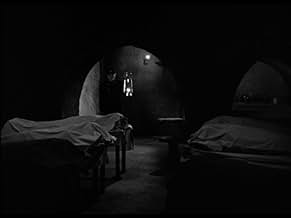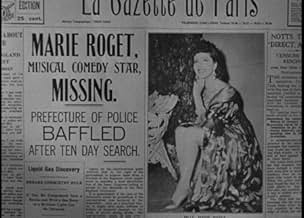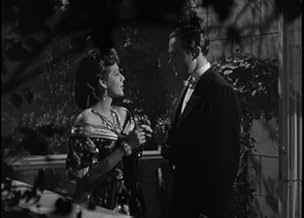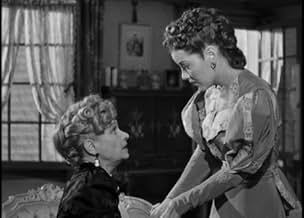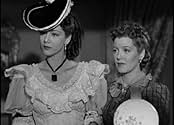IMDb RATING
5.9/10
436
YOUR RATING
A detective tries to unravel the strange circumstances surrounding the death of a young actress.A detective tries to unravel the strange circumstances surrounding the death of a young actress.A detective tries to unravel the strange circumstances surrounding the death of a young actress.
- Director
- Writers
- Stars
Paul E. Burns
- Gardener
- (as Paul Burns)
William Ruhl
- Detective
- (as Bill Ruhl)
Raymond Bailey
- Gendarme
- (uncredited)
Joseph E. Bernard
- Man
- (uncredited)
Paul Bryar
- Detective
- (uncredited)
Caroline Frances Cooke
- Woman
- (uncredited)
- Director
- Writers
- All cast & crew
- Production, box office & more at IMDbPro
Featured reviews
Maria Montez is Marie Roget. She vanishes, then reappears, then vanishes again. Some people think she will reappear again, but not police chemist Patric Knowles, who wanders around annoying police prefect Lloyd Corrigan, because he's always right.
Poe's short story was based on a real murder in New York, which he moved to Paris and actually figured out. Nothing loath, the folks at Universal kept the title, Dupin's last name, and little else. Instead, Knowles plays Dupin as a variant of Holmes, but much more annoying because he saunters. Corrigan is intended to be his Watson. A key clue is kept out of the audience's sight until after everything is solved. With Maria Ouspenskaya, John Litel, Edward Norris, and Nell O'Day.
Poe's short story was based on a real murder in New York, which he moved to Paris and actually figured out. Nothing loath, the folks at Universal kept the title, Dupin's last name, and little else. Instead, Knowles plays Dupin as a variant of Holmes, but much more annoying because he saunters. Corrigan is intended to be his Watson. A key clue is kept out of the audience's sight until after everything is solved. With Maria Ouspenskaya, John Litel, Edward Norris, and Nell O'Day.
Enjoyable Universal mystery about the murder of a not-so-nice but beautiful young woman with her fair share of male suitors. Based on an Edgar Allan Poe story, which itself was based on the real-life case of the Cigar Girl Murder that was big news in Poe's time. Starring a fine cast including many Universal contract players. The lineup includes Patric Knowles, Maria Montez, Maria Ouspenskaya, John Litel, Nell O'Day, Edward Norris, and Lloyd Corrigan. Montez plays the title character and brings her usual sex appeal. She also gets to lip sync a French tune. Knowles, one of Hollywood's great also-rans, is good as Dupin, the forensic detective. Corrigan is fun as the comic relief sidekick. It's a good B movie with a decent murder mystery. Not among the best of Universal's horror/mystery films of the 1940s but a good time-passer nonetheless.
"Mystery of Marie Roget" is a sub-par B-movie from Universal. While the story purports to be from the Edgar Allan Poe story, it's really very different.
When the film begins, Marie has been reported missing and the police have so far found nothing. They do eventually find a corpse that MIGHT be her...but her face is missing. When they tell her family that they've found her, she then walks in the house...so the corpse obviously was NOT her. However, eventually Marie really is murdered and it's up to Poe's Dupin character (Patric Knowles) to solve the murder. As for Dupin, he's a know-it-all who acts a lot like the movie version of Sherlock Holmes and has a partner (Lloyd Corrigan) who is even stupider and more useless than the movie version of Watson. In fact, he's such a bumbling moron that it totally ruins the movie...as does Dupin's bizarre manner in which he investigates. Overall, just a silly and inconsequential B murder mystery--complete with all the usual clichés and plot problems. A time-passer at best...but you could easily do better.
When the film begins, Marie has been reported missing and the police have so far found nothing. They do eventually find a corpse that MIGHT be her...but her face is missing. When they tell her family that they've found her, she then walks in the house...so the corpse obviously was NOT her. However, eventually Marie really is murdered and it's up to Poe's Dupin character (Patric Knowles) to solve the murder. As for Dupin, he's a know-it-all who acts a lot like the movie version of Sherlock Holmes and has a partner (Lloyd Corrigan) who is even stupider and more useless than the movie version of Watson. In fact, he's such a bumbling moron that it totally ruins the movie...as does Dupin's bizarre manner in which he investigates. Overall, just a silly and inconsequential B murder mystery--complete with all the usual clichés and plot problems. A time-passer at best...but you could easily do better.
This cast of B actors carries off a well-written murder mystery by Edgar Allan Poe. The sister of a woman about to inherit a large fortune plots her murder. But then she herself disappears. Who killed her? Her boyfriend (who was also courting the sister), her grandmother, her estate manager. Or her sister, to protect herself?
The events unfold with a number of false leads and dead ends, and with a few red herrings. However, due to the brilliant detective work of Dr. Dupin, who plays a Sherlock Holmes-type character to the local police chief's Watson-type character. The formula works to a degree, and we have an entertaining mystery.
The events unfold with a number of false leads and dead ends, and with a few red herrings. However, due to the brilliant detective work of Dr. Dupin, who plays a Sherlock Holmes-type character to the local police chief's Watson-type character. The formula works to a degree, and we have an entertaining mystery.
Edgar Allan Poe's three tales of Paris crime-solver C. Auguste Dupin are considered the first detective stories. "The Mystery of Marie Roget" is the least known of the three, and by far the dullest, but it has the distinction of being the first "ripped from the headlines" whodunit. Based on the unsolved murder of a minor New York celebrity named Mary Rogers, "Marie Roget" was a thinly fictionalized essay on the facts of that case and the newspapers' theories about it. (How thinly fictionalized was it? Poe even added footnotes to remind readers that he was actually talking about Mary Rogers!) There are plenty of colorful theories about why Poe came up with such a vague, confusing solution to the mystery, but he probably just didn't want to be proved wrong if the real crime was ever solved.
Any "Marie Roget" movie true to the original material would attract mostly scholars, literary buffs and insomniacs, but fortunately this film throws in elements from other Poe stories to liven things up. It also has Dupin do something a bit more exciting than sit in an armchair and deliver a lecture. He's called "Paul Dupin" here, but as Marie Roget might say, "Just call me Mary."
Any "Marie Roget" movie true to the original material would attract mostly scholars, literary buffs and insomniacs, but fortunately this film throws in elements from other Poe stories to liven things up. It also has Dupin do something a bit more exciting than sit in an armchair and deliver a lecture. He's called "Paul Dupin" here, but as Marie Roget might say, "Just call me Mary."
Did you know
- TriviaThe original Edgar Allan Poe story is based on the real-life murder of Mary Cecilia Rogers, who was found floating in the Hudson River near Weehawken, NJ. Poe transplanted the events to Paris and placed the case in the hands of amateur detective C. Auguste Dupin. In a weird twist, Poe's ultimate conclusion as to the circumstances of the crime were proved correct when the murderers confessed well after "The Mystery of Marie Roget" was published.
- Quotes
M. Henri Beauvais: Dupin? You had something to do with those murders in the Rue Morgue didn't you?
Prefect Gobelin: Something to do? Monsieur, Dr. Dupin practicaly solved those murders single handed.
- ConnectionsReferenced in DVD/Lazerdisc/VHS collection 2016 (2016)
- SoundtracksMama Dit Moi
(uncredited)
Written by Everett Carter & Milton Rosen
Sung by Dorothy Triden, dubbing Maria Montez
Details
- Release date
- Country of origin
- Official site
- Language
- Also known as
- Mystery of Marie Roget
- Filming locations
- Production company
- See more company credits at IMDbPro
- Runtime
- 1h 1m(61 min)
- Color
- Aspect ratio
- 1.37 : 1
Contribute to this page
Suggest an edit or add missing content

